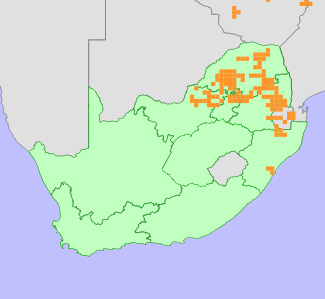| Scientific Name | Faurea saligna Harv. | Higher Classification | Dicotyledons | Family | PROTEACEAE | Synonyms | Faurea saligna Harv. subsp. saligna in sense of White, Faurea saligna Harv. subsp. xanthoneura Merxm. | Common Names | African Bean (e), African Beech (e), African Been (e), Beechwood (e), Boekenhout (e), Boekenhout (a), Bosveldbeukenhout (a), Bosveldboekenhout (a), Bosveld-boekenhout (a), Bushveld Beech (e), Bushveld Boekenhout (e), Geelboekenhout (a), Icuba Lethole (x), Isafo (x), Isefi (x), Isefu (z), Isisefo (z), Isisefu (z), Maguladali (ts), Mofufu (ns), Mofufu (tw), Mohlakô (ns), Mongêna (ns), Monyena (tw), Mutango (v), Red Beech (e), Rooiboekenhout (a), Rooi-boekenhout (a), Swartboekenhout (a), Transvaal Beech (e), Transvaal Beechwood (e), Transvaalboekenhout (a), Transvaal-boekenhout (a), Umcalathole (z), Waboom (a), Waboomhout (a), Wahout (a), Willow Beechwood (e), Witboekenhout (a) |
National Status | Status and Criteria | Least Concern | Assessment Date | 2020/04/28 | Assessor(s) | A.G. Rebelo, H. Mtshali & L. von Staden | Justification | This species is very widespread, common, and has an extent of occurrence (EOO) of 253 855 km², and an area of occupancy (AOO) of 2444 km². In South Africa, a small proportion of this species' habitat has been irreversibly modified, predominantly to timber plantations, urban developments and agriculture. There is a low rate of ongoing habitat loss, but the population is quite extensive and common, and large subpopulations are conserved in the following reserves: Ithala Game Reserve, Magaliesberg, Pilanesberg, Loskop Dam, and Motlatse Canyon reserves, Marakele and Kruger National Parks. It is therefore assessed as Least Concern. |
Distribution | Endemism | Not endemic to South Africa | Provincial distribution | Gauteng, KwaZulu-Natal, Limpopo, Mpumalanga, North West | Range | This species is widespread across northern South Africa, extending to the southern KwaZulu-Natal coast. It is also widespread in north-eastern parts of southern Africa, from Mozambique through to Kenya, eastern Uganda and Angola. |
Habitat and Ecology | Major system | Terrestrial | Major habitats | Steenkampsberg Montane Grassland, KaNgwane Montane Grassland, Soutpansberg Mountain Bushveld, Waterberg Mountain Bushveld, Western Sandy Bushveld, Springbokvlakte Thornveld, Loskop Thornveld, Loskop Mountain Bushveld, Central Sandy Bushveld, Mamabolo Mountain Bushveld, Ithala Quartzite Sourveld, Poung Dolomite Mountain Bushveld, Waterberg-Magaliesberg Summit Sourveld, Soutpansberg Summit Sourveld, Strydpoort Summit Sourveld, Wolkberg Dolomite Grassland, Northern Escarpment Quartzite Sourveld, Northern Escarpment Dolomite Grassland, Lydenburg Thornveld, Sekhukhune Montane Grassland, Barberton Montane Grassland, Dwaalboom Thornveld, Pretoriuskop Sour Bushveld, KwaZulu-Natal Hinterland Thornveld, Legogote Sour Bushveld, Tzaneen Sour Bushveld, Granite Lowveld, Crocodile Gorge Mountain Bushveld, Northern Zululand Sourveld, Southern Lebombo Bushveld, Swaziland Sour Bushveld, Polokwane Plateau Bushveld, Malelane Mountain Bushveld, KwaZulu-Natal Sandstone Sourveld, Gold Reef Mountain Bushveld, Moot Plains Bushveld, Marikana Thornveld, Pilanesberg Mountain Bushveld, Dwarsberg-Swartruggens Mountain Bushveld, Zeerust Thornveld, Sekhukhune Mountain Bushveld, Sekhukhune Plains Bushveld, Ohrigstad Mountain Bushveld, Barberton Serpentine Sourveld | Description | It occurs in low to medium-altitude woodland or grassland. It is a long-lived species, and survives fires by resprouting from underground boles or rootstocks. Wind-dispersed seeds lie on the ground and germinate. Pollinators are unknown. |
Threats | | This species has lost habitat to timber plantations, urban development and agriculture in the past. Timber plantations are no longer expanding and in many places it has been phased out and therefore this threat has ceased. A small proportion of this species' habitat has been irreversibly modified, and there is slow, ongoing habitat loss, but since the majority of this species' habitat is in protected areas and in montane areas unsuited for cultivation, overall habitat loss is suspected to be about 2% in 24 years.
There is no severe significant threat affecting this species, but some subpopulations are subjected to habitat degradation due to alien invasive plants and inappropriate fire management. |
Population | Faurea saligna is often common, usually as scattered trees. It is known from over 500 subpopulations, and the majority of these are large. The population is stable.
| Population trend | Stable |
Assessment History |
Taxon assessed |
Status and Criteria |
Citation/Red List version | | Faurea saligna Harv. | Least Concern | Raimondo et al. (2009) | |
Bibliography | Boon, R. 2010. Pooley's Trees of eastern South Africa. Flora and Fauna Publications Trust, Durban.
Burrows, J.E., Burrows, S.M., Lötter, M.C. and Schmidt, E. 2018. Trees and shrubs Mozambique. Publishing Print Matters, Cape Town.
Chisumpa, S.M., Brummitt, R.K. and Marner, S. 2006. Proteaceae. In: G.V. Pope, R.M. Polhill and E.S. Martins (eds). Flora Zambesiaca 9 (Part 3):49-85. Flora Zambesiaca Managing Committee, Royal Botanic Gardens, Kew.
Raimondo, D., von Staden, L., Foden, W., Victor, J.E., Helme, N.A., Turner, R.C., Kamundi, D.A. and Manyama, P.A. 2009. Red List of South African Plants. Strelitzia 25. South African National Biodiversity Institute, Pretoria.
Rebelo, T. 2001. Sasol Proteas: A field guide to the proteas of southern Africa. (2nd ed.). Fernwood Press, Vlaeberg, Cape Town.
Schmidt, E., Lotter, M. and McCleland, W. 2002. Trees and shrubs of Mpumalanga and Kruger National Park. Jacana, Johannesburg.
|
Citation | | Rebelo, A.G., Mtshali, H. & von Staden, L. 2020. Faurea saligna Harv. National Assessment: Red List of South African Plants version 2024.1. Accessed on 2025/09/30 |
 Comment on this assessment Comment on this assessment
|
Search for images of Faurea saligna on iNaturalist
|
 Comment on this assessment
Comment on this assessment

